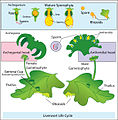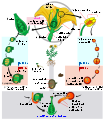Diplohaplont
Diplohaplons or Haplo-Diplonts are living beings whose reproduction alternates between haploid and diploid generations . This type of generation change is called heterophasic (Greek ἕτερος heteros, “the other”, “unequal”) because the degree of ploidy (the core phase) of the generations is different (see core phase change ). The diplohaplons include all "higher" plants ( embryophyta or land plants) and most algae , but of the animals only the unicellular foraminifera .
It is characteristic of diplohaplons that mitoses occur in both the haploid and the diploid phase , i. H. Core divisions without changing the core phase. The haploid generation reproduces sexually by forming female and male sex cells ( gametes ). It is therefore called the gametophyte . The union of two gametes of different sexes and the fusion of the cell nuclei ( fertilization ) creates a diploid zygote , the first cell of the diploid generation. This reproduces asexually by forming haploid spores after a reduction division ( meiosis ) . It is therefore called a sporophyte . The next haploid generation grows from the spores.
Both the gametophyte and the sporophyte are multicellular, but the two generations usually have completely different appearing manifestations. The diplohaplonts are differentiated from haplonts , in which only the zygote is diploid - these include some algae and animal protozoa - and diplonts , in which only the gametes are haploid - these include most animals and humans.
A term that is only etymologically similar is haplodiploidy , a form of gender determination .
Research history
Wilhelm Hofmeister first described in 1851 that all higher plants or land plants have a life cycle with two alternating multicellular generations. Ladislav Josef Čelakovský recognized that the sporophyte is phylogenetically younger than the gametophyte. In 1874, he presented the two generations as opposing because they are morphologically different, develop differently and have different functions in the life cycle. Nathanael Pringsheim took a contrary ( as far as we know today wrong) view was in 1878 when he regarded the two generations as homologous and interpreted the conditions in mosses , in which the gametophyte is subordinate to the sporophyte, as phylogenetically derived. At that time, sexual reproduction was not understood. The process of fertilization was known, but the complementary process of meiosis was not clarified until 1883 by Édouard van Beneden . Only then did it become clear that the generation change in plants cannot be equated with that in animals because there is no nuclear phase change. How the evolutionarily new diploid generation came about was explained by Frederick Orpen Bower in 1908: by delaying meiosis, as mitoses occurred in the diploid phase.
Land plants (Embryophyta)
Overview
Life cycles of different land plants:
Mosses
Gametophytes and sporophytes of the liverwort Pellia epiphylla
Spore capsule of the deciduous moss Physcomitrella patens
The haploid generation, the gametophyte, is the outwardly dominant “real” green moss plant of the liver moss and deciduous moss. It exists in two sexes, male and female, and forms sex organs ( gametangia ), which in the female sex are called archegonia and contain the egg cell . The male gametangia are called antheridia ; bifurcated spermatozoids develop in them . Water is necessary for fertilization because the male gametes have to swim to the female ones.
The diploid zygote develops into an embryo and then into a sporophyte. In mosses, this remains connected to the gametophyte and receives water and nutrients from it. It grows through the archegonium and usually forms a stalk (the seta ) with a spore capsule ( sporangium ) at the tip . Alternatively, a stalk can be formed from the gametophyte, which is then called a pseudopodium and carries the sporophyte at its tip. Haploid spores are formed in the spore capsule by meiosis. The stem allows the wind to spread the spores better. A filamentous pre-germ, the protonema , grows from spores that fall to the ground . The haploid moss plants form on this from buds, and the cycle is closed.
In hornworts the haploid gametophyte is a lobed, flat thallus . There is no protonema. After fertilization, the sporophyte grows horn-shaped or pod-shaped out of the gametophyte. It is green and photosynthesis, but like the other mosses it remains dependent on the mother plant. The next haploid generation grows out of spores that the sporophyte forms.
Ferns

The ferns of the diploid sporophyte is reversed the dominant generation. After meiosis, haploid spores are formed on the underside of fern fronds, which fall to the ground or are spread by the wind and, under suitable conditions, produce the haploid generation. This is called prothallium in ferns and is similar to the thallus of hornworts. It remains significantly smaller than the diploid fern plant, usually only one to two centimeters when fully grown, and reproduces sexually (gametophyte). Here, too, water is necessary for fertilization, through which the spermatozoids can reach the egg cells.
Seed plants

In the seed plants , too , the sporophytes dominate the gametophytes. The “real” plant is the sporophyte generation, while the gametophytes are only a few cells in size.
Reproductive organs grow on the diploid plant in the form of flowers with carpels and stamens . Haploid cells are formed in these through meiosis. From these, the haploid generation grows on the plant, but it remains tiny. The female gametophyte is the embryo sac in the ovule, usually consisting of only a few cells . The male gametophytes are the microspores formed on the stamens that grow into the haploid, multicellular interior of pollen grains . In contrast to ferns and mosses, fertilization is independent of the water. During pollination , the pollen grain is first transferred to the carpel. There it forms a pollen tube that grows into the carpel to form the plant egg. This is where the actual fertilization takes place.
The diploid zygote is formed during fertilization. This first grows into a diploid seed on the parent plant . Then the seed pauses in growth, during which it can survive periods of great drought and cold without damage. The seed then germinates under favorable environmental conditions (heat and moisture) . The new plant develops from the germ through mitosis.
The seed plants can either be monoecious or dioecious . The monoecious have both female and male flowers on the same plant. The flowers themselves are unisexual, so either have only (male) stamens or only (female) carpels. In dioecious seed plants, female and male flowers only occur on separate individuals. There are also “genuinely hermaphrodite” plants that have only one type of flower, in which male and female sexual organs are located at the same time.
evolution
The closest relatives of the Embryophyta, the candelabrum algae , are haplonts, i.e. with the exception of the zygote, haploid. In contrast, all embryophytes form multicellular diploid sporophytes. In the most original embryophytes, liver mosses and deciduous mosses, these are not capable of photosynthesis and therefore, like the zygote of chandelier algae, depend on the nutrition of the mother plant (the gametophyte). In the horn mosses, which are more closely related to the vascular plants than the other mosses, the sporophytes are photosynthetically active (which occurs only to a small extent in some deciduous mosses), but remain dependent on the supply of the mother plant. In the vascular plants (club moss plants , ferns and seed plants), finally, the sporophyte is a self-sufficient, free-living organism, and in the case of the seed plants, conversely, the greatly reduced gametophyte has switched to complete nutrition by the mother plant. A transition stage between the mosses and today's vascular plants with well-developed gametophytes and sporophytes are shown by some early land plants that are only preserved in fossil form.
The free-living sporophyte of the vascular plants differs in several respects very much from the sporophytes of the mosses sitting on the gametophyte. Fundamental is the development of a root as a new type of organ, without which independence would not be possible. This includes the lack of or weak ability of the mosses to react to gravity ( gravitropism ), with the root positively gravitropically following gravity, while the shoot grows vertically upwards (negative gravitropism). The leaves on the side of the stem axis are also new. The enlargement and independence of the sporophyte was accompanied by a reduction and internalization (internalization) of the gametophyte. The latter began with the horn moss when the archegonia sank in the thallus. There was also heterospore , an increasing specialization of male and female spores.
The sporangium of the moss is an evolutionary new development, i.e. not homologous to the organs of algae that are also designated. It consists of sporogenic (spore-forming) tissue and a shell. It is the only organ present in the sporophytes of all embryophyta. In mosses, the sporophyte consists only of a sporangium and a stalk. In the seed plants, the sporangia are differentiated as pollen sacs on the stamens and as nucellus in the ovule .
Seaweed
Most green algae are haplonts, but there are also diplohaplons. In the latter, the generation change can be isomorphic; H. the haploid and diploid generations are outwardly the same, for example in sea lettuce , or heteromorphic, with the diploid generation coming to the fore.
Many, but not all, brown algae are diplohaplons and undergo a heterophasic generation change. Originally, this generation change was isomorphic, as is the case with most species of the genus Ectocarpus . From this, brown algae developed with a heteromorphic generation change, in which the two generations have different appearance. With the Fucales , the haploid generation has regressed to such an extent that they are almost pure diplonts; they are no longer considered diplohaplons. Many algae form spores that are flagellated and therefore move freely in water. They are called zoospores or swarm spores.
The red algae are diplohaplonts with a unique tripartite generation change: A haploid generation consists of male and female gametophytes. The male gametes are not flagellated and are passively driven in the water to the female gametes, which are located in a gametangium of the female gametophyte. There it comes to fertilization. The diploid zygote grows directly on the gametophyte to the second generation, which mostly consists of inconspicuous, microscopic cell threads and is called carposporophyte . The carposporophyte forms bare, diploid, uncultivated carpospores. From these germinates a third generation, also diploid, called the tetrasporophyte , which again forms an autonomous organism. The layman can hardly distinguish the tetrasporophyte from the gametophyte, since both are almost identical in shape and size. The tetrasporophyte forms four haploid spores, which are called tetrameiospores, from each spore mother cell with reduction division. They drift away and a new haploid generation grows out of them.
Individual evidence
- ↑ a b c d Lin-Yong Qiu, Alexander B. Taylor, Hilary A. McManus: Evolution of the life cycle in land plants . Journal of Systematics and Evolution 50 (2012), pp. 171-194.
- ^ Joachim W. Kadereit, Christian Körner, Benedikt Kost, Uwe Sonnewald: Strasburger Textbook of Plant Sciences . Springer Spectrum, Berlin / Heidelberg 2014, p. 591.







